|
Size: 14834
Comment:
|
Size: 16165
Comment:
|
| Deletions are marked like this. | Additions are marked like this. |
| Line 100: | Line 100: |
| 08:15 - after flux calibration maps on Uranus and Mars (scans 45 & 47)- the telescope was sent to 0851+202, at ~12 deg. from the Sun position, for a first ''light'' experiment about the reaction of the telescope after painting as seen by NIKA2. Kept there for ~1h with FWHM/flux measurements every ~10 min. Then, the calib_1scan on Mars and Uranus were repeated (scans 74 & 76). A summary of the results of this test in 2 mm band is shown below: | 08:15 - After flux calibration maps on Uranus and Mars (scans 45 & 47)- the telescope was sent to 0851+202, at ~12 deg. from the Sun position, for a first ''light'' experiment about the reaction of the telescope after painting as seen by NIKA2. Kept there for ~1h with FWHM/flux measurements every ~10 min. Then, the calib_1scan on Mars and Uranus were repeated (scans 74 & 76). A summary of the results of this test in 2 mm band is shown below: |
| Line 138: | Line 138: |
| 16:30 - The OHB team installed the new version of the ACU's control loop. Although Tau_225 GHz ~ 0.6 and unstable atmosphere, we did some preliminary tracking tests for ~1.5h using focus sequences with NIKA2, with peak wind speed between 6-9 m/s. Tracking profiles after that intervention are consistently better than the previous ones. Overshooting effects at the beginning of sub-scan segments no longer appear. Below is an example of the tracking profile before the HBO intervention (scan 20240814s10, El. ~43.5 deg., max. wind speed 3 m/s) and after it (scan 20240814s90, El. 46.2 deg., max wind speed 7.5 m/s). | 16:30 - 17:50 The OHB team installed the new version of the ACU's control loop. Although Tau_225 GHz ~ 0.6 and unstable atmosphere, we did some preliminary tracking tests for ~1.5h using focus sequences with NIKA2, with peak wind speed between 6-9 m/s. Tracking profiles after that intervention are consistently better than the previous ones. Overshooting effects at the beginning of sub-scan segments no longer appear. Below is an example of the tracking profile before the HBO intervention (scan 20240814s10, El. ~43.5 deg., max. wind speed 3 m/s) and after it (scan 20240814s90, El. 46.2 deg., max wind speed 7.5 m/s). |
| Line 175: | Line 175: |
| DAQ restarted—bad KIDs: 29, 2, 36 (ar 1, 2, 3): 22:40 DAQ restarted—bad KIDs: 29, 2, 39 (ar 1, 2, 3): 04:30 Mercury: apparent size 11" |
04:30 - Angel: DAQ restarted—bad KIDs: 29, 2, 39 (ar 1, 2, 3). Tau_225 GHz ~ 0.4, wind speed < 3 m/s. Starting with focus on Uranus; stable atmosphere in the l.o.s. Hexapod got stuck several times during the session (scans 19, 41, 66). It was necessary to restart NCS services a couple of times after canceling focus sequences. Beam map on Uranus. Then, a series of flux calibration scans on NGC7027, Neptune, Mars, Uranus, and GL490 (just in case). * M4-damage testing (missing) Observations of Mercury (apparent size: 11"; angular distance to the Sun: 7 deg.; Sun avoidance is set to 5 deg.) were also tried. Flux fractions retrieved for Mercury are about 41% (MB & AP). High background rms levels (e.g. a factor ~5 higher -at 2 mm- than the obtained one on Uranus position) in PIIC-QL maps. Gaussian fittings do not show signs of saturation (to be examined). The telescope was there for about 1h. Continuing with flux calibration scans on Uranus, alpha Ori, Mars, and CRL618. The atmosphere becomes unstable starting at ~13h. Opacity is increasing steeply. On the other hand, except for alpha Ori, no more flux standards are available at reasonable elevations. Stopping NIKA2 session at 14:15 (LT). 22:40 - Angel: DAQ restarted—bad KIDs: 29, 2, 36 (ar 1, 2, 3). |
| Line 237: | Line 243: |
| 12:30 - Angel (remote), Joaquin: Agreed in a staff meeting in the morning to give priority to calibration observations with NIKA2 to fill the observation gap of 10h < UT < 21h. Wind speed < 9 m/s; tau[225 GHz] ~ 0.25. DAQ started. Impossible to lower the count of bad KIDs from ~190 in arrays 1 and 2 when working on the resonances. Atmosphere looks unstable. Checking crates for these arrays anyway. Bad KIDs counts with the NIKA2 window closed: 28, 2, 24 (ar1, ar2, ar3). Window reopened and DAQ restarted. Bad KIDs counts: 196, 4, 168. Window closed again. Switching to Het. pool account, project 085-24 (EMIR E0+E1). Unable to get a decent pointing in both bands (anomalous refraction). Giving up; telescope parked at 15:10 (LT). | 12:30 - Angel (remote), Joaquin: Agreed in a staff meeting in the morning to give priority to calibration observations with NIKA2 to fill the observation gap of 10h < UT < 21h. Wind speed < 9 m/s; tau[225 GHz] ~ 0.25. DAQ started. Impossible to lower the count of bad KIDs from ~190 in arrays 1 and 2 when working on the resonances. The atmosphere looks unstable. Checking crates for these arrays anyway. Bad KIDs counts with the NIKA2 window closed: 28, 2, 24. Window reopened and DAQ restarted. Bad KIDs counts: 196, 4, 168 (ar 1, 2, 3). Window closed again. Switching to Het. pool account, project 085-24 (EMIR E0+E1). Unable to get a decent pointing in both bands (anomalous refraction). Giving up. Telescope parked at 15:10 (LT). |
| Line 242: | Line 248: |
| 14:00 - Angel (remote), Joaquin: Wind speed < 5 m/s; tau[225 GHz] ~ 0.78. Telescope is parked since ~1h ago, when Het. pool observations of project 021-24 (GP) were suspended when pwv_l.o.s. > 15 mm; awful pointing in E0 band. Waiting for any improvement. Difficult to produce any progress on calibration data with NIKA2 under these conditions. | 14:00 - Angel (remote), Joaquin: Wind speed < 5 m/s; tau[225 GHz] ~ 0.78. Telescope is parked since ~1h ago, when Het. pool observations of project 021-24 (GP) were suspended when pwv_l.o.s. > 15 mm; awful pointing in E0 band. Waiting for any improvement. It is difficult to produce any progress on calibration data with NIKA2 under these conditions. |
| Line 247: | Line 253: |
| 13:00 - Angel (remote), Joaquin: | 13:00 - Angel (remote), Joaquin: Unstable atmosphere. Telescope parked just before the beginning of this shift, except for periodic tests with pointing scans with EMIR (3 mm). Signs of anomalous refraction. |
Back to the NIKA2 Run 67 main page
Daily Reports
Contents
IRAM staff at Pico:
OoD until Tue. 13th morning: Gloria Liñan (day), Joaquin Santiago (night)
OoD on Aug. 13-20: Enrique Lobato (day), Pedro Martinez (night)
Rx & Astro: Dave John, Carlos Duran, Miguel Sanchez, Pablo Torne, Angel Bongiovanni
OoD on Aug. 20-27: Joaquin Santiago (day), Sergio Amaya (night)
Relevant hardware conditions at starting:
- An improvement of air pipes, wiring, sensors, and control systems of the vertex is being finished by Rx team this week. The styrofoam membrane was relocated to the standard position before the NIKA2 observations. No petals have been installed yet in the vertex. Some pieces of foam layers need to be replaced between the petals and the styrofoam membrane.
- 15:30 (LT): Last NIKA2 cooling down steps (DJ): turning on amplifiers of 1 mm arrays. No evident PT noise. Bad KIDs (window closed): 16, 1, 25 (ar 1, 2, 3)
- 20:20 (LT): Opening NIKA2 window, El. 60 deg. Waiting for a final T_MC stabilization (172 mK). Bad KIDs: 30, 3, 43 (ar1, 2, 3)
Note: contents of daily reports will be improved/updated at the end of current week
August 12th, Monday
21:10 - Miguel, Angel: Starting with tau225GHz~0.45; a drop is expected. Mild wind speed (~6-8 m/s). DAQ restarted—bad KIDs: 31, 4, 35 (ar 1, 2, 3). The NIKA2 pointing model is not updated. The first pointing try was on 1741-038. The only issues initially were a bad indent in the make_IMBFITS_nika.py code and a high deviation of the source in El. (~80") in the very first map. The latter issue was fixed after repositioning M5 & M6 (JS).
Relatively stable atmosphere over the night, with several short periods of instabilities/opacity spikes, especially at the beginning of the observations. Sidelobes max. values are well contained in maps at mean elevations, that is, about what was reached after the lateral focus session held in the last NIKA2 pool week (12-19/3/2024): <6% at 2 mm and <12% at 1 mm. Bad scan (tracking deviations >20%) although wind speed was <6 m/s: 20240812s169. Flux calibration scans on NGC7027, CRL26088, and MWC349. Beam map on 2251+158.
23:50 - High elevation scans (azel system) revisited after ASSSA commissioning using NIKA2. The maximum scan speed allowed (i.e. under the current NCS capabilities) as a function of elevation is as follows. Scan with invalid antenna traces: 20240812s199. Maybe because the El. limit allowed by NCS was reached. For the time being, any attempt must be limited to El. = 89 deg and the following max. scan speeds:
Elevation (deg) |
Scan speed (arcsec/s) |
80 |
30 |
83 |
20 |
84 |
15 |
86 |
10 |
88 |
10 |
[Comment: What is limiting the maximum scanning speed ? Is it pako or is it the new drive ? <CK>]. The limitations live in the NCS (not in paKo) and they will be changed asap. A ticket related to this issue will be opened (cf. Minutes of the coordination meeting held on Aug. 19th).
Summary of calibration scans:
- Valid calib_1scan maps:
Source |
Scan |
FWHM (2 mm) |
MB flux (2 mm) |
AP flux (2 mm) |
Sidelobes max. (2 mm) |
NGC7027 |
20240812s189 |
18.3" x 19.1" |
84.7% |
86.1% |
5.8% |
MWC349 |
20240812s190 |
17.4" x 17.8" |
86.7% |
88.5% |
6.8% |
CRL2688 |
20240812s191 |
17.9" x 18.1" |
80.3% |
82.3% |
6.8% |
- Valid beam map:
Source |
Scan |
FWHM (2 mm) |
MB flux (2 mm) |
AP flux (2 mm) |
Sidelobes max. (2 mm) |
2251+158 |
20240812s213 |
17.5" x 18.0" |
5.17 Jy |
5.25 Jy |
4.6% |
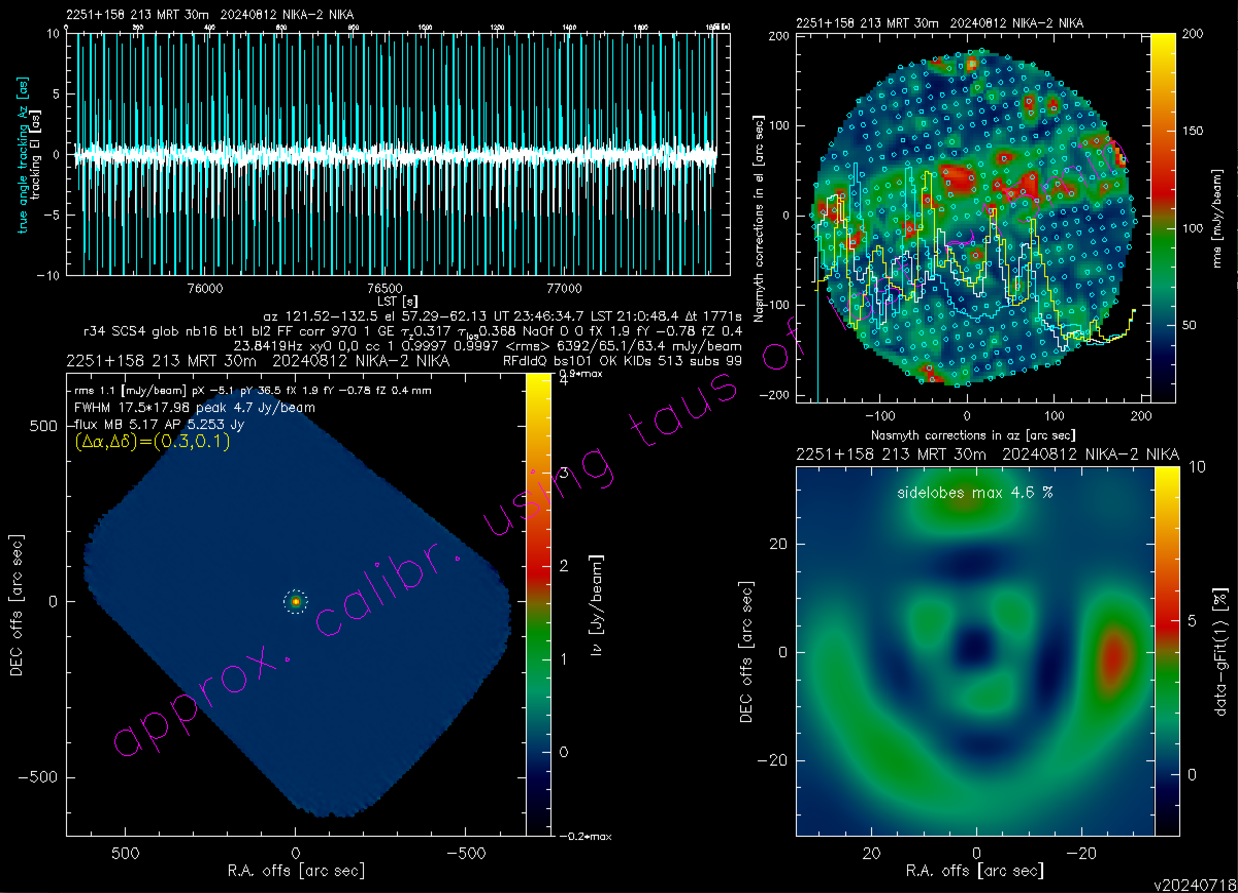
August 13th, Tuesday
00:00 - Angel: starting with flux calibrations on Uranus and Neptune; stable atmosphere during the period. Tau_225 GHz < 0.35, wind speed < 11 m/s. Beam map on Uranus at 05:30 (LT). Bad scans (tracking deviations >20%): 20240813s1, s2, s7. Wind speed was between 10 and 11 m/s in these cases.
06:15 - NIKA2 session finished to give a chance to complete EMIR calibration sequences on Uranus & Mars, as well as to continue the works at the vertex.
22:40 - Miguel, Angel: works on vertex finished (DJ, CD, PM); resuming NIKA2 observations. Fairly stable. Flux calibrations on NGC7027 and Neptune.
Summary of calibration scans:
- Valid calib_1scan maps:
Source |
Scan |
FWHM (2 mm) |
MB flux (2 mm) |
AP flux (2 mm) |
Neptune |
20240813s4 |
17.6" x 18.1" |
95.8% |
96.2% |
Uranus |
20240813s8 |
18.0" x 19.0" |
100.5% |
102.5% |
Neptune |
20240813s17 |
17.37" x 17.8" |
97.2% |
97.3% |
NGC7027 |
20240813s113 |
18.4" x 19.0" |
86.0% |
87.2% |
Neptune |
20240813s124 |
17.8" x 18.4" |
89.3% |
90.8% |
- Valid beam map:
Source |
Scan |
FWHM (2 mm) |
MB flux (2 mm) |
AP flux (2 mm) |
Uranus |
20240813s29 |
17.5" x 18.2" |
97.7% |
99.7% |
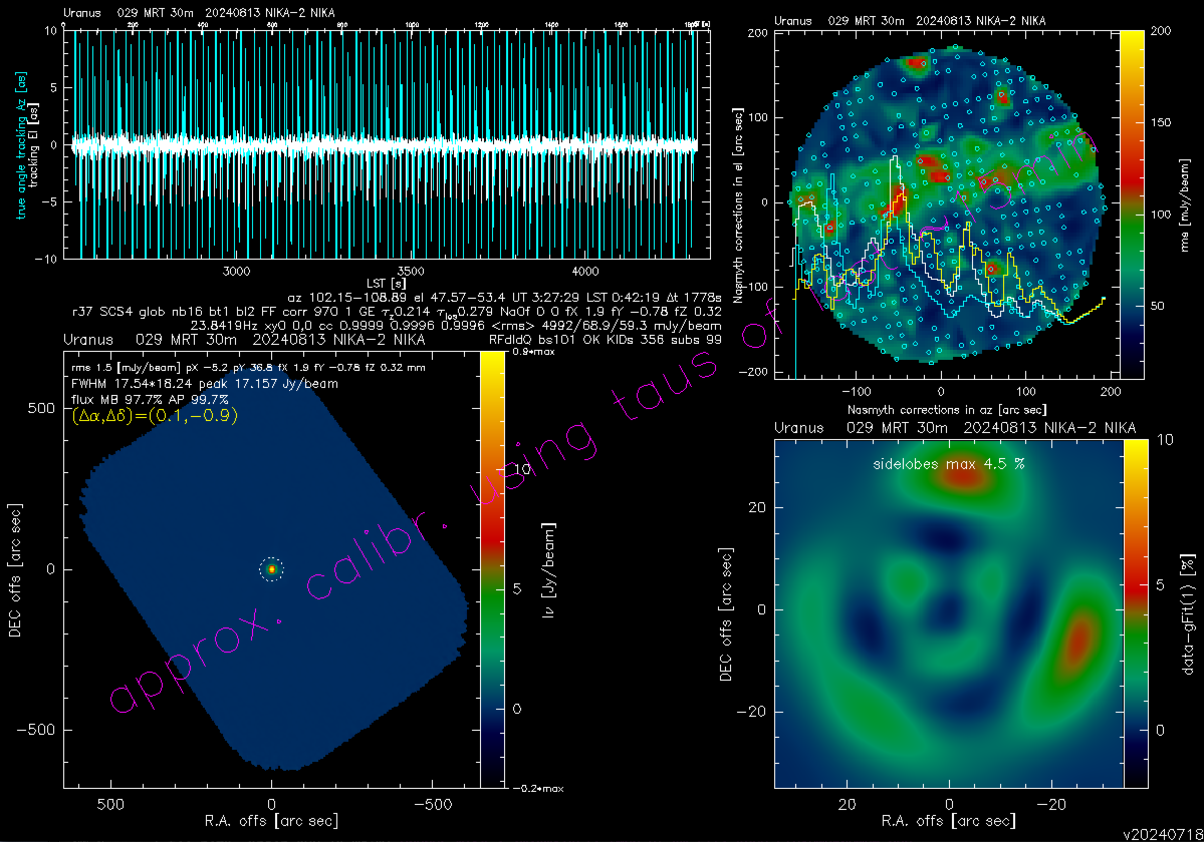
August 14th, Wednesday
00:00 - Angel: continuing calibrations on Uranus. Tau_225 GHz ~ 0.3-0.4, wind speed < 4 m/s. Looks stable. Occasional opacity spikes around 05:30 (LT), just when the beam map on Uranus was running (scan 20). Flux calibration scans on Neptune, Uranus, Mars (apparent size: 6.1"), and the triad NGC7027, CRL26088, MWC349. Bad scan in the middle of a focus sequence on Mars (tracking deviations >20%): 20240814s64.
08:15 - After flux calibration maps on Uranus and Mars (scans 45 & 47)- the telescope was sent to 0851+202, at ~12 deg. from the Sun position, for a first light experiment about the reaction of the telescope after painting as seen by NIKA2. Kept there for ~1h with FWHM/flux measurements every ~10 min. Then, the calib_1scan on Mars and Uranus were repeated (scans 74 & 76). A summary of the results of this test in 2 mm band is shown below:
Mars before Sun exposition (calib_1scan; El. 64.8 deg.):
UT
FWHM (ar 2)
MB flux (ar 2)
AP flux (ar 2)
FWHM (ar 1)
MB flux (ar 1)
AP flux (ar 1)
05:59
17.9" x 18.1"
97.8%
100.8%
12.4" x 13.6"
94.5%
109.8%
Uranus before Sun exposition (calib_1scan; El. 72.2 deg.):
UT
FWHM (ar 2)
MB flux (ar 2)
AP flux (ar 2)
FWHM (ar 1)
MB flux (ar 1)
AP flux (ar 1)
06:11
17.4" x 18.1"
96.8
100.4
11.6" x 12.2"
89.4%
110.9%
0851+202 - Direct all-dish Sun radiation on M1 (pointing scans):
UT
FWHM (ar 2)
MB flux (ar 2)
AP flux (ar 2)
FWHM (ar 1)
MB flux (ar 1)
AP flux (ar 1)
06:21
17.8" x 18.3"
3.92 Jy
3.98 Jy
12.1" x 14.8"
2.32 Jy
2.84 Jy
06:31
17.4" x 19.4"
3.74 Jy
3.78 Jy
15.5" x 18.5"
2.82 Jy
3.02 Jy
06:41
17.4" x 18.9"
3.64 Jy
3.77 Jy
11.8" x 13.3"
1.85 Jy
2.29 Jy
06:51
17.2" x 18.4"
3.48 Jy
3.51 Jy
12.4" x 15.0"
2.03 Jy
1.3 Jy
07:01
18.5" x 21.7"
3.46 Jy
3.53 Jy
15.0" x 20.7"
2.14 Jy
2.24 Jy
07:08
FOCUS
07:19
18.2" x 19.5"
3.71 Jy
3.72 Jy
12.2" x 15.0"
1.91 Jy
2.14 Jy
Mars after Sun exposition (calib_1scan; El. 74.3 deg.) and focus correction:
UT
FWHM (ar 2)
MB flux (ar 2)
AP flux (ar 2)
FWHM (ar 1)
MB flux (ar 1)
AP flux (ar 1)
08:00
FOCUS
08:11
18.0" x 18.4"
93.2
97.1
12.5" x 13.1"
90.5%
111.0%
Uranus after Sun (calib_1scan; El. ):
UT
FWHM (ar 2)
MB flux (ar 2)
AP flux (ar 2)
FWHM (ar 1)
MB flux (ar 1)
AP flux (ar 1)
08:16
17.5" x 17.8"
98.0
98.0
11.5" x 11.8"
90.8%
107.0%
At the position of 0851+202, the background <rms> was a factor ~1.3-2 (ar 2) and ~1.5-3 (ar 1) higher than values obtained at the position of Mars or Uranus. The beam geometry is not significantly distorted during the test. FWHM values in Uranus and Mars remained within reasonable limits after refocusing.
10:00 - NIKA2 session stopped. Control of the telescope passed to OHB until ~16h (estimated) by agreement, for the installation of a new version of the tracking control loop in the ACU and appropriate testing.
16:30 - 17:50 The OHB team installed the new version of the ACU's control loop. Although Tau_225 GHz ~ 0.6 and unstable atmosphere, we did some preliminary tracking tests for ~1.5h using focus sequences with NIKA2, with peak wind speed between 6-9 m/s. Tracking profiles after that intervention are consistently better than the previous ones. Overshooting effects at the beginning of sub-scan segments no longer appear. Below is an example of the tracking profile before the HBO intervention (scan 20240814s10, El. ~43.5 deg., max. wind speed 3 m/s) and after it (scan 20240814s90, El. 46.2 deg., max wind speed 7.5 m/s).
![]()
![]()
The improvement looks clear. More tests with different wind regimes and telescope attitudes are necessary. PT is working on the data compilation and the analysis of the tracking profiles.
Summary of calibration scans:
- Valid calib_1scan maps:
Source |
Scan |
FWHM (2 mm) |
MB flux (2 mm) |
AP flux (2 mm) |
Mars |
20240814s22 |
18.2" x 18.8" |
97.3% |
98.8% |
MWC349 |
20240814s31 |
18.0" x 18.2" |
100.6% |
101.4% |
CRL2688 |
20240814s32 |
18.3" x 18.8" |
92.2% |
93.0% |
NGC7027 |
20240814s33 |
18.7" x 19.3" |
95.9% |
96.3% |
Neptune |
20240814s36 |
17.6" x 17.9" |
98.8% |
100.1% |
Mars |
20240814s45 |
17.9" x 18.7" |
97.9% |
100.8% |
Uranus |
20240814s47 |
17.4" x 18.1" |
96.8% |
100.4% |
Mars |
20240814s74 |
18.0" x 18.4" |
93.2% |
97.1% |
Uranus |
20240814s76 |
17.5" x 17.8" |
96.1% |
98.0% |
- Valid beam map:
Source |
Scan |
FWHM (2 mm) |
MB flux (2 mm) |
AP flux (2 mm) |
Uranus |
20240814s20 |
17.525" x 18.274" |
90.043% |
91.574% |
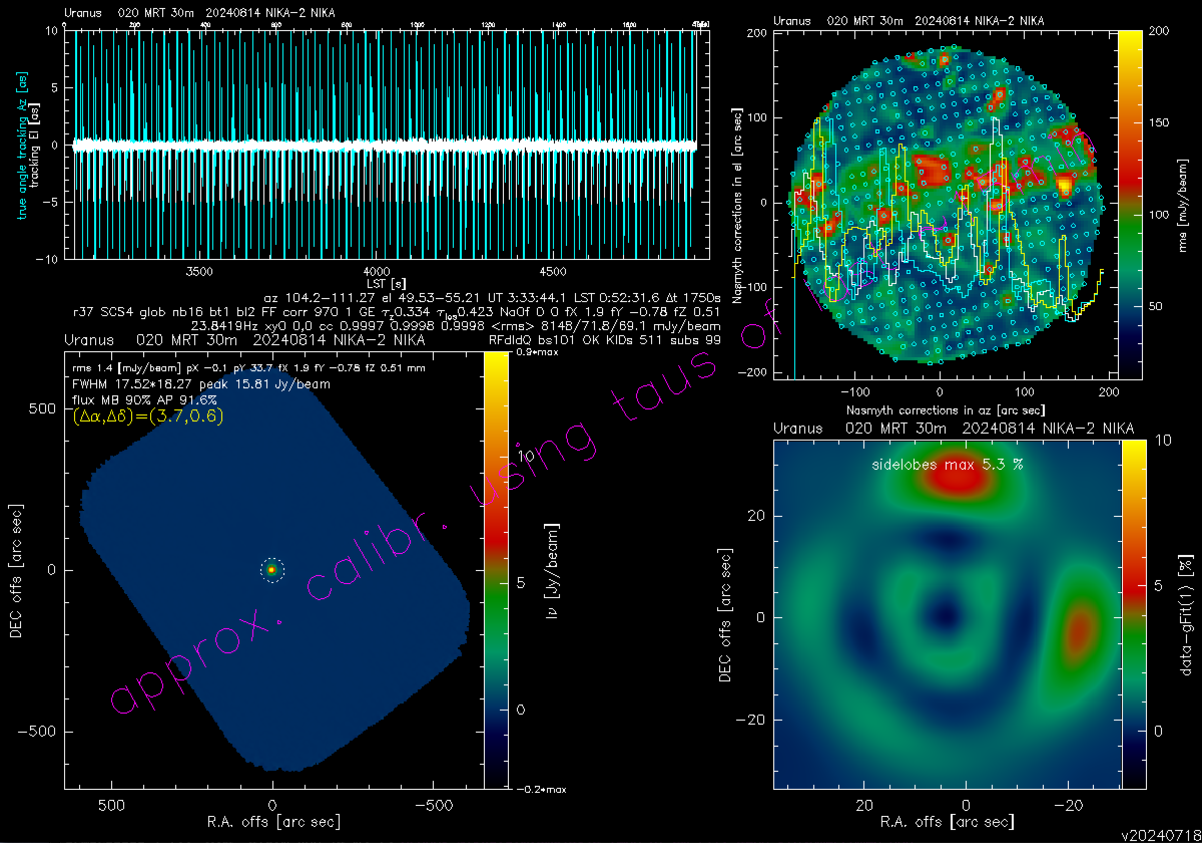
August 15th, Thursday
No observations are scheduled. National holiday.
August 16th, Friday
04:30 - Angel: DAQ restarted—bad KIDs: 29, 2, 39 (ar 1, 2, 3). Tau_225 GHz ~ 0.4, wind speed < 3 m/s. Starting with focus on Uranus; stable atmosphere in the l.o.s. Hexapod got stuck several times during the session (scans 19, 41, 66). It was necessary to restart NCS services a couple of times after canceling focus sequences. Beam map on Uranus. Then, a series of flux calibration scans on NGC7027, Neptune, Mars, Uranus, and GL490 (just in case).
- M4-damage testing (missing)
Observations of Mercury (apparent size: 11"; angular distance to the Sun: 7 deg.; Sun avoidance is set to 5 deg.) were also tried. Flux fractions retrieved for Mercury are about 41% (MB & AP). High background rms levels (e.g. a factor ~5 higher -at 2 mm- than the obtained one on Uranus position) in PIIC-QL maps. Gaussian fittings do not show signs of saturation (to be examined). The telescope was there for about 1h. Continuing with flux calibration scans on Uranus, alpha Ori, Mars, and CRL618. The atmosphere becomes unstable starting at ~13h. Opacity is increasing steeply. On the other hand, except for alpha Ori, no more flux standards are available at reasonable elevations. Stopping NIKA2 session at 14:15 (LT).
22:40 - Angel: DAQ restarted—bad KIDs: 29, 2, 36 (ar 1, 2, 3).
Summary of calibration scans:
- Valid calib_1scan maps:
Source |
Scan |
FWHM (2 mm) |
MB flux (2 mm) |
AP flux (2 mm) |
NGC7027 |
20240816s62 |
18.8" x 20.3" |
101.9% |
105.9% |
Neptune |
20240816s65 |
17.9" x 18.2" |
98.3% |
102.1% |
Mars |
20240816s74 |
17.9" x 18.5" |
98.5% |
101.7% |
Uranus |
20240816s77 |
17.4" x 17.7" |
98.2% |
100.8% |
GL490 |
20240816s80 |
18.1" x 19.6" |
0.87 Jy |
1.05 Jy |
Mercury |
20240816s91 |
19.1" x 20.3" |
41.3% |
41.8% |
Mercury |
20240816s98 |
18.9" x 20.6" |
40.7% |
41.4% |
Uranus |
20240816s107 |
17.7" x 18.4" |
98.2% |
101.3% |
ALFORI |
20240816s110 |
17.4" x 18.1" |
0.19 Jy |
0.20 Jy |
Mars |
20240816s118 |
18.5" x 19.3" |
96.0% |
98.5% |
CRL618 |
20240816s121 |
19.1" x 19.3" |
88.9% |
91.6% |
NGC7027 |
20240816s264 |
18.9" x 19.5" |
95.7% |
98.2% |
CRL2688 |
20240816s265 |
18.3" x 18.4" |
92.4% |
91.5% |
MWC349 |
20240816s266 |
17.6" x 17.8" |
97.3% |
100.3% |
MWC349 |
20240816s274 |
17.4" x 17.7" |
97.4% |
101.6% |
CRL2688 |
20240816s275 |
17.8" x 18.2" |
92.8% |
98.2% |
NGC7027 |
20240816s276 |
18.9" x 19.7" |
92.7% |
97.2% |
- Valid beam maps:
Source |
Scan |
FWHM (2 mm) |
MB flux (2 mm) |
AP flux (2 mm) |
Uranus |
20240816s50 |
17.3" x 18.0" |
98.9% |
102.2% |
2251+158 |
20240816s285 |
17.5" x 18.1" |
5.50 Jy |
5.61 Jy |
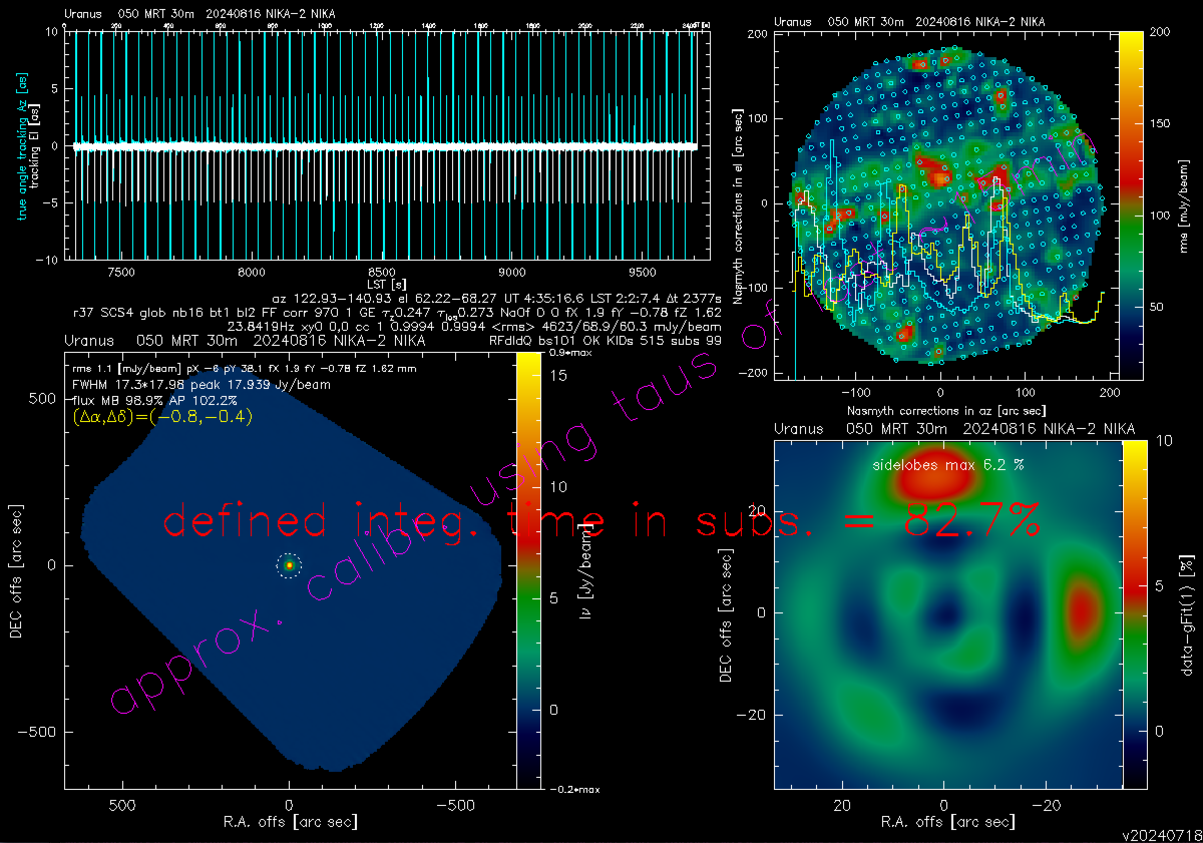

August 17th, Saturday
Summary of calibration scans:
- Valid calib_1scan maps:
Source |
Scan |
FWHM (2 mm) |
MB flux (2 mm) |
AP flux (2 mm) |
MWC349 |
20240817s31 |
18.0" x 18.0" |
106.4% |
108.9% |
CRL2688 |
20240817s33 |
18.1" x 18.4" |
97.7% |
100.7% |
NGC7027 |
20240817s34 |
18.8" x 19.1" |
99.6% |
101.6% |
Neptune |
20240817s37 |
17.7" x 17.8" |
99.8% |
101.4% |
Uranus |
20240817s46 |
17.4" x 17.8" |
100.8% |
104.0% |
- Valid beam map:
Source |
Scan |
FWHM (2 mm) |
MB flux (2 mm) |
AP flux (2 mm) |
Uranus |
20240817s27 |
17.6" x 18.4" |
99.7% |
102.2% |
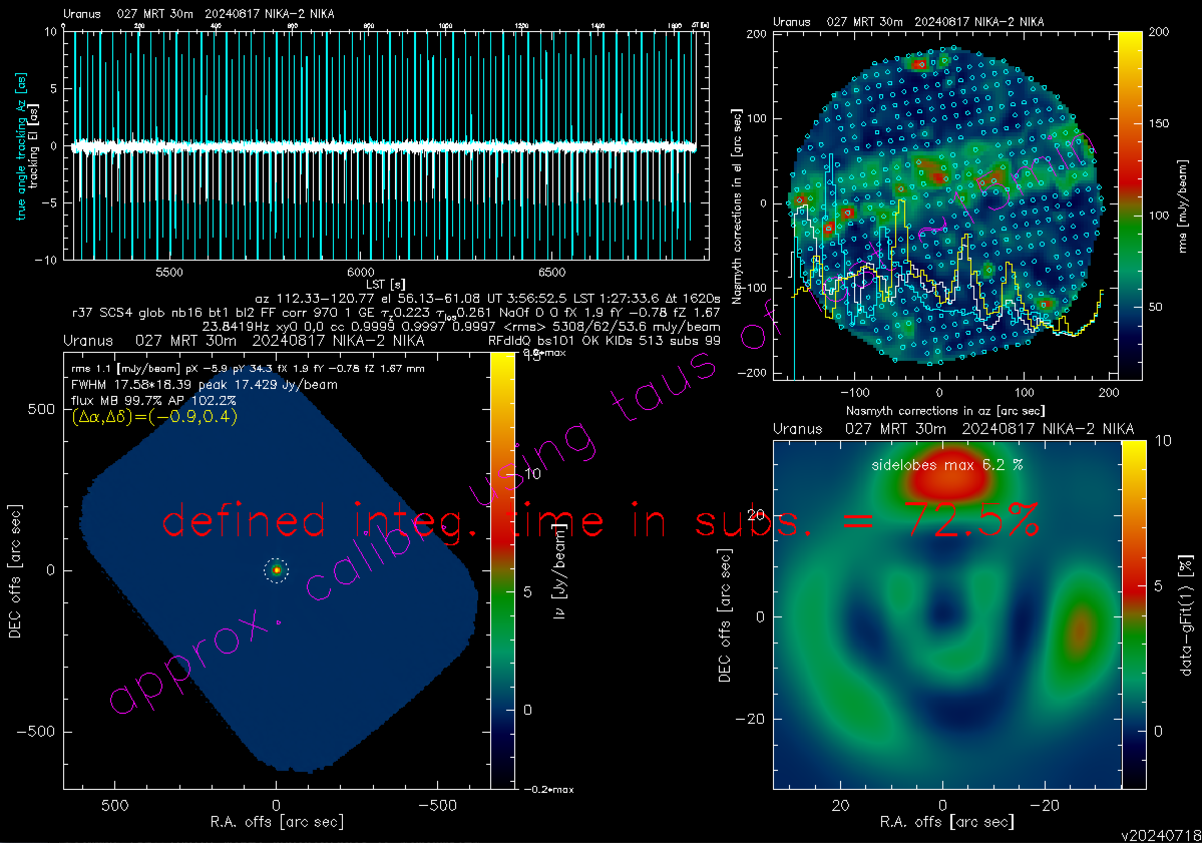
August 18th-22nd
August 23rd, Friday
12:30 - Angel (remote), Joaquin: Agreed in a staff meeting in the morning to give priority to calibration observations with NIKA2 to fill the observation gap of 10h < UT < 21h. Wind speed < 9 m/s; tau[225 GHz] ~ 0.25. DAQ started. Impossible to lower the count of bad KIDs from ~190 in arrays 1 and 2 when working on the resonances. The atmosphere looks unstable. Checking crates for these arrays anyway. Bad KIDs counts with the NIKA2 window closed: 28, 2, 24. Window reopened and DAQ restarted. Bad KIDs counts: 196, 4, 168 (ar 1, 2, 3). Window closed again. Switching to Het. pool account, project 085-24 (EMIR E0+E1). Unable to get a decent pointing in both bands (anomalous refraction). Giving up. Telescope parked at 15:10 (LT).
August 24th, Saturday
14:00 - Angel (remote), Joaquin: Wind speed < 5 m/s; tau[225 GHz] ~ 0.78. Telescope is parked since ~1h ago, when Het. pool observations of project 021-24 (GP) were suspended when pwv_l.o.s. > 15 mm; awful pointing in E0 band. Waiting for any improvement. It is difficult to produce any progress on calibration data with NIKA2 under these conditions.
August 24th, Saturday
13:00 - Angel (remote), Joaquin: Unstable atmosphere. Telescope parked just before the beginning of this shift, except for periodic tests with pointing scans with EMIR (3 mm). Signs of anomalous refraction.
